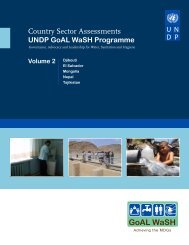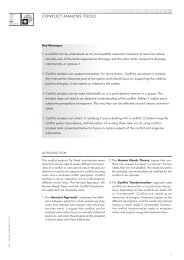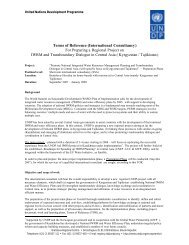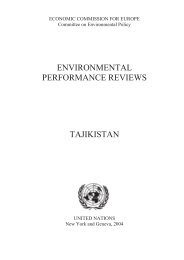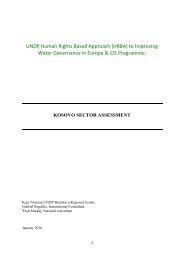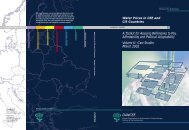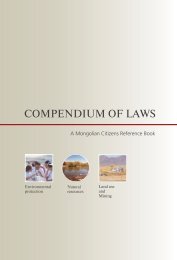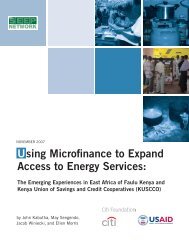- Page 1 and 2:
Public Disclosure AuthorizedOptions
- Page 4 and 5:
Natural Resourcesand ViolentConflic
- Page 6 and 7:
ContentsPrefaceContributorsAcronyms
- Page 10 and 11:
PrefaceRECENT RESEARCH UNDERTAKEN B
- Page 12:
prefacexiespecially Nicholas Stern,
- Page 15 and 16:
xivcontributorsSylviane Guillaumont
- Page 18 and 19:
Acronyms and AbbreviationsAUCCCAMLR
- Page 20 and 21:
chapter 1Natural Resources andConfl
- Page 22 and 23:
natural resources and conflict 3Fig
- Page 24 and 25:
natural resources and conflict 5rig
- Page 26 and 27:
natural resources and conflict 7War
- Page 28 and 29:
natural resources and conflict 9pro
- Page 30 and 31:
natural resources and conflict 11ag
- Page 32 and 33:
natural resources and conflict 13ar
- Page 34 and 35:
natural resources and conflict 15re
- Page 36:
chapter 2The Natural Resource Curse
- Page 39 and 40:
20 michael rossEconomic GrowthIt ma
- Page 41 and 42:
22 michael ross12 of the 20 as “h
- Page 43 and 44:
24 michael rossvolatile than the pr
- Page 45 and 46:
26 michael rossby the military, giv
- Page 47 and 48:
28 michael rosswars in regions that
- Page 49 and 50:
30 michael rossIncrease Transparenc
- Page 51 and 52:
32 michael ross• InSierra Leone i
- Page 53 and 54:
34 michael rossgroups have also tur
- Page 55 and 56:
36 michael rossgenerate extraordina
- Page 57 and 58:
38 michael rossand arms to the Nati
- Page 59 and 60:
40 michael rossHegre, Håvard. 2002
- Page 61 and 62:
42 michael rossRelation to Sierra L
- Page 63 and 64:
44 swanson, oldgard, and lundemeani
- Page 65 and 66:
46 swanson, oldgard, and lunde(U.K.
- Page 67 and 68:
48 swanson, oldgard, and lunderesou
- Page 69 and 70:
50 swanson, oldgard, and lundeinfor
- Page 71 and 72:
52 swanson, oldgard, and lundeon of
- Page 73 and 74:
54 swanson, oldgard, and lundeFund
- Page 75 and 76:
56 swanson, oldgard, and lundecompa
- Page 77 and 78:
58 swanson, oldgard, and lundeSimil
- Page 79 and 80:
60 swanson, oldgard, and lundeThe f
- Page 81 and 82:
62 swanson, oldgard, and lundeorgan
- Page 83 and 84:
64 swanson, oldgard, and lundeThere
- Page 85 and 86:
66 swanson, oldgard, and lundenongo
- Page 87 and 88:
68 swanson, oldgard, and lundefrom
- Page 89 and 90:
70 swanson, oldgard, and lundenatur
- Page 91 and 92:
72 swanson, oldgard, and lundeflows
- Page 93 and 94:
74 swanson, oldgard, and lundeBox 3
- Page 95 and 96:
76 swanson, oldgard, and lundepayme
- Page 97 and 98:
78 swanson, oldgard, and lundePolic
- Page 99 and 100:
80 swanson, oldgard, and lundeof pa
- Page 101 and 102:
82 swanson, oldgard, and lundethe U
- Page 103 and 104:
84 swanson, oldgard, and lundegover
- Page 105 and 106:
86 swanson, oldgard, and lundeNever
- Page 107 and 108:
88 swanson, oldgard, and lundeleast
- Page 109 and 110:
90 swanson, oldgard, and lundecondi
- Page 111 and 112:
92 swanson, oldgard, and lunde27. S
- Page 113 and 114:
94 swanson, oldgard, and lunde—
- Page 115 and 116:
96 swanson, oldgard, and lunde—
- Page 117 and 118:
98 crossin, hayman, and taylorThere
- Page 119 and 120:
100 crossin, hayman, and taylorTabl
- Page 121 and 122:
102 crossin, hayman, and taylor•
- Page 123 and 124:
104 crossin, hayman, and taylorThus
- Page 125 and 126:
106 crossin, hayman, and taylorCTRs
- Page 127 and 128:
108 crossin, hayman, and taylorIn e
- Page 129 and 130:
110 crossin, hayman, and taylorto h
- Page 131 and 132:
112 crossin, hayman, and taylorCert
- Page 133 and 134:
114 crossin, hayman, and taylorof p
- Page 135 and 136:
116 crossin, hayman, and taylorBox
- Page 137 and 138:
118 crossin, hayman, and taylorA la
- Page 139 and 140:
120Table 4.2 Forest Product Monitor
- Page 141 and 142:
122Table 4.2 (continued)Technology
- Page 143 and 144:
124 crossin, hayman, and taylorthat
- Page 145 and 146:
126 crossin, hayman, and taylorprov
- Page 147 and 148:
128 crossin, hayman, and taylor•
- Page 149 and 150:
130 crossin, hayman, and taylorinte
- Page 151 and 152:
132 crossin, hayman, and taylorThe
- Page 153 and 154:
134 crossin, hayman, and taylorMixi
- Page 155 and 156:
136 crossin, hayman, and taylorsmug
- Page 157 and 158:
138 crossin, hayman, and taylorof t
- Page 159 and 160:
140 crossin, hayman, and taylorlabe
- Page 161 and 162:
142 crossin, hayman, and taylor33 m
- Page 163 and 164:
144 crossin, hayman, and taylor•
- Page 165 and 166:
146 crossin, hayman, and taylorcomm
- Page 167 and 168:
148 crossin, hayman, and taylorto p
- Page 169 and 170:
150 crossin, hayman, and taylorare
- Page 171 and 172:
152 crossin, hayman, and taylordeve
- Page 173 and 174:
154 crossin, hayman, and taylorinte
- Page 175 and 176:
156 crossin, hayman, and tayloror p
- Page 177 and 178:
158 crossin, hayman, and taylorthe
- Page 180 and 181:
chapter 5Follow the Money: The Fina
- Page 182 and 183:
follow the money 163existing standa
- Page 184 and 185:
follow the money 165various institu
- Page 186 and 187:
follow the money 167portion of the
- Page 188 and 189:
follow the money 169funded their wa
- Page 190 and 191:
follow the money 171• Use undergr
- Page 192 and 193:
follow the money 173EmbargoesAn ong
- Page 194 and 195:
follow the money 175violating secto
- Page 196 and 197:
follow the money 177category. Howev
- Page 198 and 199:
follow the money 179of weapons and
- Page 200 and 201:
follow the money 181in June 2002 by
- Page 202 and 203:
follow the money 183The resolution
- Page 204 and 205:
follow the money 185• Enter into
- Page 206 and 207:
follow the money 187to establish th
- Page 208 and 209:
follow the money 189in general, not
- Page 210 and 211:
follow the money 191Current capacit
- Page 212 and 213:
follow the money 193laundering and
- Page 214 and 215:
follow the money 195system and law
- Page 216 and 217:
follow the money 197lawful purpose,
- Page 218 and 219:
follow the money 199in criminal mat
- Page 220 and 221:
follow the money 201Canada, Germany
- Page 222 and 223:
follow the money 203means that the
- Page 224 and 225:
follow the money 205the wholesale o
- Page 226 and 227:
follow the money 207Prior to the Se
- Page 228 and 229:
follow the money 2092. Current memb
- Page 230 and 231:
follow the money 211of all firearms
- Page 232 and 233:
follow the money 213“Four Compani
- Page 234 and 235:
chapter 6Getting It Done: Instrumen
- Page 236 and 237:
getting it done 217objective of end
- Page 238 and 239:
getting it done 219Fourth, under ce
- Page 240 and 241: getting it done 221The proliferatio
- Page 242 and 243: getting it done 223Mandatory and vo
- Page 244 and 245: Table 6.1 Overview of International
- Page 246 and 247: 227CertificationregimesKimberleyCer
- Page 248 and 249: getting it done 229instruments, and
- Page 250 and 251: getting it done 231recently been en
- Page 252 and 253: getting it done 233$500 million. 8
- Page 254 and 255: getting it done 235The argument tha
- Page 256 and 257: getting it done 237legislation and
- Page 258 and 259: getting it done 239Many observers a
- Page 260 and 261: getting it done 241International Le
- Page 262 and 263: getting it done 243panels could pro
- Page 264 and 265: getting it done 245international ro
- Page 266 and 267: getting it done 247scheme is now ir
- Page 268 and 269: getting it done 249of forest resour
- Page 270 and 271: getting it done 251standing and com
- Page 272 and 273: getting it done 253peace agreements
- Page 274 and 275: getting it done 2551997 and 2001 (
- Page 276 and 277: getting it done 257themselves with
- Page 278 and 279: getting it done 259Box 6.3 Mandator
- Page 280 and 281: getting it done 261agencies, and ci
- Page 282 and 283: getting it done 263enterprises coul
- Page 284 and 285: getting it done 265ethical investme
- Page 286 and 287: getting it done 267Advocacy groups
- Page 288 and 289: getting it done 269principles, with
- Page 292 and 293: getting it done 273to focus the att
- Page 294 and 295: getting it done 275Given that it de
- Page 296 and 297: getting it done 277The assessments
- Page 298 and 299: getting it done 27925. See www.inte
- Page 300 and 301: getting it done 281ReferencesThe wo
- Page 302 and 303: getting it done 283Harden, Blain. 2
- Page 304 and 305: getting it done 285Africa: Assessin
- Page 306 and 307: chapter 7Attracting Reputable Compa
- Page 308 and 309: attracting reputable companies 289h
- Page 310 and 311: attracting reputable companies 291i
- Page 312 and 313: attracting reputable companies 293b
- Page 314 and 315: attracting reputable companies 295t
- Page 316 and 317: attracting reputable companies 297T
- Page 318 and 319: attracting reputable companies 299b
- Page 320 and 321: attracting reputable companies 301S
- Page 322 and 323: attracting reputable companies 303h
- Page 324 and 325: attracting reputable companies 305T
- Page 326 and 327: attracting reputable companies 307o
- Page 328 and 329: attracting reputable companies 309T
- Page 330 and 331: attracting reputable companies 311T
- Page 332 and 333: attracting reputable companies 313o
- Page 334 and 335: attracting reputable companies 315e
- Page 336 and 337: attracting reputable companies 317I
- Page 338 and 339: attracting reputable companies 319I
- Page 340 and 341:
attracting reputable companies 321i
- Page 342 and 343:
attracting reputable companies 323o
- Page 344 and 345:
attracting reputable companies 325$
- Page 346 and 347:
attracting reputable companies 327
- Page 348 and 349:
attracting reputable companies 329m
- Page 350 and 351:
attracting reputable companies 331t
- Page 352 and 353:
attracting reputable companies 333L
- Page 354 and 355:
attracting reputable companies 335a
- Page 356 and 357:
attracting reputable companies 337N
- Page 358 and 359:
attracting reputable companies 339I
- Page 360 and 361:
attracting reputable companies 341b
- Page 362 and 363:
attracting reputable companies 343s
- Page 364 and 365:
attracting reputable companies 345a
- Page 366 and 367:
attracting reputable companies 347G
- Page 368 and 369:
attracting reputable companies 349W
- Page 370 and 371:
attracting reputable companies 351A
- Page 372 and 373:
chapter 8Dampening Price ShocksPatr
- Page 374 and 375:
dampening price shocks 355in lower
- Page 376 and 377:
dampening price shocks 357the agree
- Page 378 and 379:
dampening price shocks 359common re
- Page 380 and 381:
dampening price shocks 361flexibili
- Page 382 and 383:
dampening price shocks 363create a
- Page 384 and 385:
dampening price shocks 365different
- Page 386:
dampening price shocks 367———
- Page 389 and 390:
370 indexand Pakistan, 170; possibl
- Page 391 and 392:
372 index“Dutch disease,” 82; r
- Page 393 and 394:
374 indexeconomic rationale for, 34
- Page 395 and 396:
376 indexor regional arrangements,
- Page 397 and 398:
378 indexstandards and norms, 172,1
- Page 399 and 400:
380 indexEmbargoes: and black marke
- Page 401 and 402:
382 indexRUF-controlled areas in Si
- Page 403 and 404:
384 indexForest Law Enforcement and
- Page 405 and 406:
386 indexGreater Nile Petroleum Ope
- Page 407 and 408:
388 indexInformation technology:
- Page 409 and 410:
390 indexand reputation, 294-97; mi
- Page 411 and 412:
392 indexLiberia audit its use of r
- Page 413 and 414:
394 indexMorley Fund Management:inv
- Page 415 and 416:
396 indexOffice of the High Commiss
- Page 417 and 418:
398 indexPolicy recommendations for
- Page 419 and 420:
400 indexnatural resource revenues,
- Page 421 and 422:
402 indexSri Lanka: double agenda o
- Page 423 and 424:
404 indexover-allocation of logging
- Page 425 and 426:
406 index156-57 n7; pilot program t
- Page 427 and 428:
408 indexWal-Mart: child labor rest
- Page 429:
Violent conflict can spell catastro





